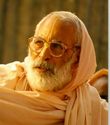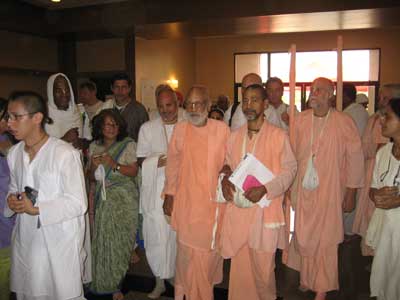

The “2007 Houston Bhakti Yoga Retreat – Festival of Love and Devotion” began on May 29th. Over five-hundred devotees attended the festival, having come from all over America and from as far as Europe, South and Central America, and India. Many new persons from Houston also attended, having received invitations from the devotees or having seen the advertisements in the form of flyers, newspaper articles, etc.
Held in a large hall adjacent to the Durgabari Temple on Schiller Road, the first evening program began with the worship of the Srimad-Bhagavatam. Srila Narayana Maharaja personally performed the bhoga offering and arati (offering incense, ghee lamp and flowers) to the Bhagavatam, with the consideration that the Bhagavatam is the literary incarnation of Sri Krsna. Then, considering that Sri Krsna is never without His internal pleasure potency, Srimati Radhika, and that Srimad-Bhagavatam is thus the literary incarnation of the Divine Couple Sri Sri Radha-Krsna, he led the assembled devotees in singing the arati song, “Jaya jaya Radha-Krsna yugala milana.”
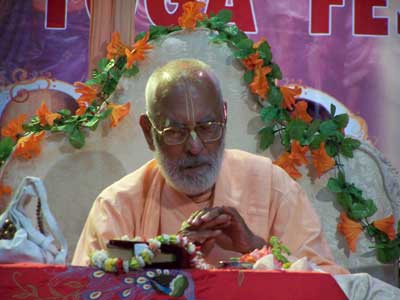
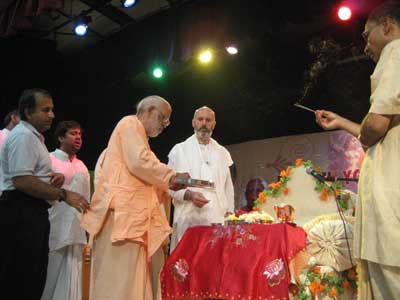
The Srimad-Bhagavatam was then taken on procession around the temple, while ladies carried kalasas on their head, and everyone performed kirtana.
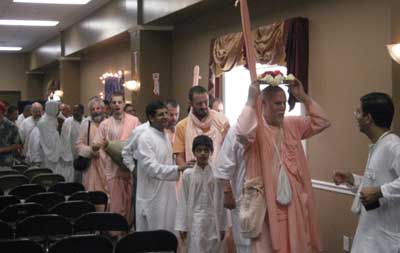
For our readers who are not familiar with the meaning of the the kalasa, Srila Narayana Maharaja explained that it is a copper pot that is full of water and auspicious mango leaves, and marked with the auspicious sign of the svastika. On top of the copper pot is a coconut, an auspicious fruit which nutritionally satisfies one’s hunger and thirst, and which has on its shell three ‘eyes’, or holes, which are likened to the three eyes of the auspicious Lord Siva.
The ceremony of carrying the kalasa in procession is included with various types of religious events to invoke auspiciousness. Srila Narayana Maharaja said that the ladies should carry these kalasas while wearing beautiful garments.
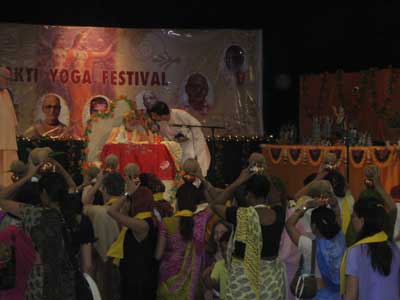
Although the procession took place only on the first and last nights, the bhoga offering and arati to Sri Krsna’s form as Srimad-Bhagavatam was performed every evening before Srila Narayana Maharaja’s Srimad-Bhagavatam discourse.
On the first night he began his glorification of Srimad-Bhagavatam by glorifying Sri Srimad Bhaktivedanta Swami Prabhupada, who brought the Srimad-Bhagavatam to the Western world. He told the devotees and guests in his audience that it was because of Srila Prabhupada that they had come to Krsna consciousness, and that it is by Srila Prabhupada’s mercy that he himself is so successfully preaching the message of Bhagavatam all over the world.
After that, Srila Narayana Maharaja discussed the history of Lord Visnu’s first revealing the Bhagavatam to Lord Brahma, the first created being, and then he discussed the history of its coming to be written by Srila Vyasadeva and later spoken by Srila Sukadeva Gosvami. He then described the events leading to its recitation by Srila Suta Gosvami to the sages in Naimisaranya forest, and then he began to explain the glories of hearing the Bhagavatam with reference to its First Canto.
He then explained how the Supreme Personality of Godhead Sri Krsna, the Supreme Cause of innumerable universes, in His Supreme feature, is absorbed in sweet, loving pastimes as a cowherd-boy. He explained how, by hearing such pastimes from self realized spiritual masters, a soul can transcend the cycle of birth, old age, disease and death.
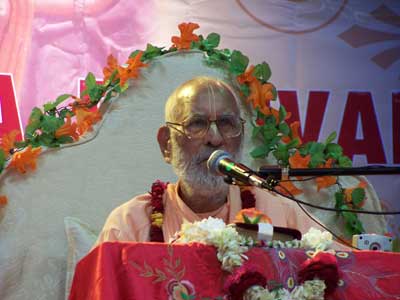
The following is an excerpt from Srila Narayana Maharaja’s lecture on May 31st:
“Sri Krsna performed so many pastimes. When He was about 2 years and 6 months old, Upananda (Krsna’s uncle) and all the cowherd-men had a meeting. In that meeting Upananda said, “We have been facing so many problems here recently. So many demons are coming. We should leave Gokula and go to Vrndavana. Yamuna River is nearby there, along with plenty of grass and trees, and so many places for the boys to play. We should all go there with our cows and calves.
“It was declared that all the residents of Gokula would leave the following day for Vrndavana, so all the families were present for that procession. Mother Yasoda and Rohini rode on a bullock cart with Krsna and Baladeva. All the elderly persons, ladies and children also sat on bullock carts, and in this way all the Vrajavasis arrived in the village of Cattikara.
“There was actually no village at that time. The Vrajavasis crossed the river Yamuna and reached Vrndavana, and there in Cattikara they created a village – by keeping their bullock carts in a semi-circle and keeping the remaining area fenced by thorn trees. Sri Krsna, Nanda Baba, Upananda and all their associates stayed there for some time.
“When Krsna reached the age of three or four years old, Krsna told His mother and father, “I must take the cows out for herding.” They could not check Him, although they wanted to because of His young age. Therefore on a good day, Gopastami, Krsna began to go out with Balarama and His friends to the forest, to take the calves for grazing.
“One day, while the boys were out cow-herding, Vatsasura, a demon in the form of a calf, began thinking, “How shall I kill Krsna?” After Vatsasura entered the midst of Krsna and His friends and calves, the calves smelled his bad odor and began running here and there. Krsna told Baladeva by signals from His eyes, “Oh, look at this! This is a demon!” After jointly making Their decision regarding how to proceed, Sri Krsna took the demon’s hind legs, twirled him around, and thus killed him.”
On the last three nights of the festival, Srila Narayana Maharaja discussed Sri Krsna’s pastimes with the gopis. Just as it was done by his predecessor, Srila Sukadeva Gosvami, in his recitation of these pastimes, Srila Narayana Maharaja interwove his own discussion with philosophy so that the audience would understand the Lord’s activities properly. He discussed the Bhagavatam’s chapters called “Venu-gita (the Song of Krsna’s Flute)”, the introduction to the “Rasa Dance,” the “Gopis’ Song of Separation,” and finally “The Reunion.” On these last three nights Srila Narayana Maharaja spoke in Hindi, and his discourse was intermittently translated by Sripad Damodara Maharaja and Sripad Visnu dasa Adhikari.

On Friday and Sunday mornings Srila Maharaja gave harinama and brahminical initiation to many of the devotees in attendance. Throughout each day he met with old and new devotees, and answered many questions about the management of his preaching mission and also about the philosophy of bhakti-yoga.
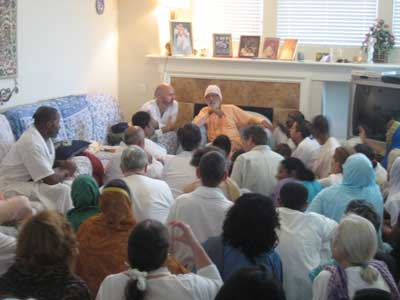
After initiations on Sunday morning, Srila Narayana Maharaja met with some of the devotees who have been helping with the translation, editing, and production of his books. In the presence of twelve senior devotees, important documents were signed in order to insure that all his books are properly copyright protected.
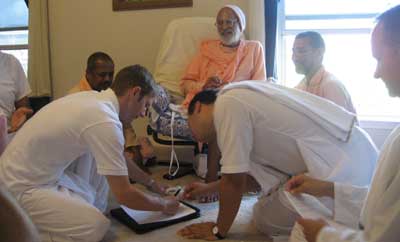
On each of the six days, from 11am to 4pm, the Bhakti Yoga Summer Camp for children held its classes in front of the Deities at the Durgabari temple, just next door to the festival hall. The Camp was organized by some of the senior members of Srila Narayana Maharaja’s Houston IGVS (International Gaudiya Vedanta Society), and conducted by the teachers from the New Vraja Village School in Badger, California. Each day, about 40 children from different parts of America, from the ages of four to fourteen, learned how to enrich their Krsna consciousness through art and drama projects, devotional games and songs, arati, puja, and honoring of Krsna prasada.
During some of the evening programs, just after Srila Narayana Maharaja’s classes the children performed dramas. On one evening they performed the beautiful drama of Dvarakadhisa Krsna and Sudama brahmana, based on the authoritative Vedic scripture, Srimad-Bhagavatam, and Srila Narayana Maharaja wept in spiritual happiness as he watched. On another evening their teachers performed and exciting and humorous drama about Krsna’s pastimes in Vrndavana.
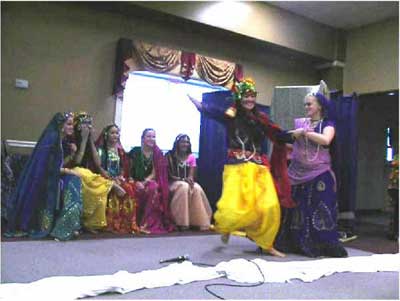
On the final evening, the children went on the stage to present some of their artwork. They recited a Sanskrit verse from Bhagavad-gita for Srila Narayana Maharaja and the assembled devotees and guests in the audience, and received their Bhakti Yoga Summer Camp diplomas from Srila Maharaja’s hands.
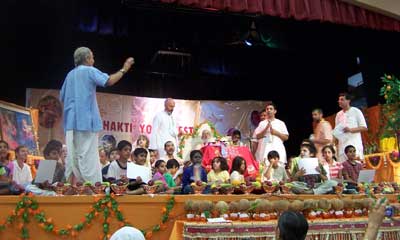
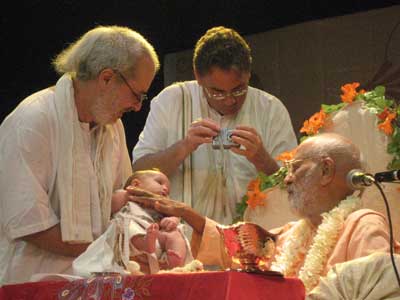
The senior management and the original founding trustees of the Durgabari temple enjoyed the programs so much, and were so happy, that they requested Srila Narayana Maharaja to use the facility for the Bhakti Yoga Festival next year. They promised to bear the entire cost of next year’s festival.
Gaudiya Vedanta Society Houston thanked the Houston Durgabari Society for all their co-operation this year in making the festival a grand success. For further correspondence, please write to igvs_houston@yahoo.com.
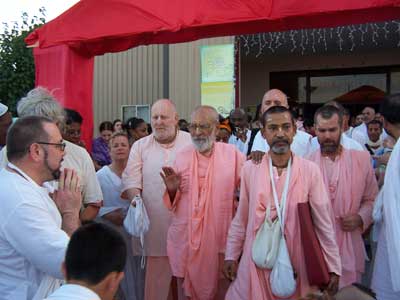
![[BVML Home Page]](../../grfx/bml_logo.gif)
